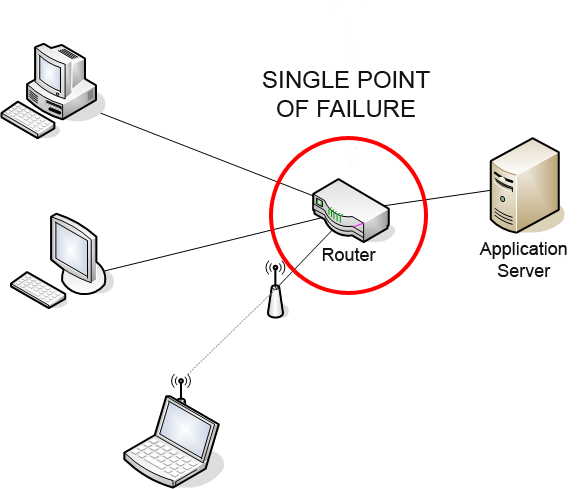|
Availability Zone
In cloud computing, an availability zone is a subset of an IT infrastructure system that shares no service-critical components (including power, cooling and access) with any other availability zone. Availability zones are typically geographically separated from one another, to prevent local disasters from acting on more than one availability zone. Some service providers also make higher-level regional distinctions between availability zones, allowing service providers to mitigate even regional-level disasters such as earthquakes and forest fires. Applications requiring high availability are typically implemented as distributed systems that span multiple availability zones. Services offering distinct availability zones include Amazon Web Services, Microsoft Azure and Google Cloud. See also * Single point of failure A single point of failure (SPOF) is a part of a system that would Cascading failure, stop the entire system from working if it were to fail. The term single poi ... [...More Info...] [...Related Items...] OR: [Wikipedia] [Google] [Baidu] |
Cloud Computing
Cloud computing is "a paradigm for enabling network access to a scalable and elastic pool of shareable physical or virtual resources with self-service provisioning and administration on-demand," according to International Organization for Standardization, ISO. Essential characteristics In 2011, the National Institute of Standards and Technology (NIST) identified five "essential characteristics" for cloud systems. Below are the exact definitions according to NIST: * On-demand self-service: "A consumer can unilaterally provision computing capabilities, such as server time and network storage, as needed automatically without requiring human interaction with each service provider." * Broad network access: "Capabilities are available over the network and accessed through standard mechanisms that promote use by heterogeneous thin or thick client platforms (e.g., mobile phones, tablets, laptops, and workstations)." * Pooling (resource management), Resource pooling: " The provider' ... [...More Info...] [...Related Items...] OR: [Wikipedia] [Google] [Baidu] |
High Availability
High availability (HA) is a characteristic of a system that aims to ensure an agreed level of operational performance, usually uptime, for a higher than normal period. There is now more dependence on these systems as a result of modernization. For example, to carry out their regular daily tasks, hospitals and data centers need their systems to be highly available. Availability refers to the ability of the user to access a service or system, whether to submit new work, update or modify existing work, or retrieve the results of previous work. If a user cannot access the system, it is considered ''unavailable from the user's perspective''. The term '' downtime'' is generally used to refer to describe periods when a system is unavailable. Resilience High availability is a property of network resilience, the ability to "provide and maintain an acceptable level of service in the face of faults and challenges to normal operation." Threats and challenges for services can range from ... [...More Info...] [...Related Items...] OR: [Wikipedia] [Google] [Baidu] |
Distributed Computing
Distributed computing is a field of computer science that studies distributed systems, defined as computer systems whose inter-communicating components are located on different networked computers. The components of a distributed system communicate and coordinate their actions by passing messages to one another in order to achieve a common goal. Three significant challenges of distributed systems are: maintaining concurrency of components, overcoming the lack of a global clock, and managing the independent failure of components. When a component of one system fails, the entire system does not fail. Examples of distributed systems vary from SOA-based systems to microservices to massively multiplayer online games to peer-to-peer applications. Distributed systems cost significantly more than monolithic architectures, primarily due to increased needs for additional hardware, servers, gateways, firewalls, new subnets, proxies, and so on. Also, distributed systems are prone to ... [...More Info...] [...Related Items...] OR: [Wikipedia] [Google] [Baidu] |
Amazon Web Services
Amazon Web Services, Inc. (AWS) is a subsidiary of Amazon.com, Amazon that provides Software as a service, on-demand cloud computing computing platform, platforms and Application programming interface, APIs to individuals, companies, and governments, on a metered, pay-as-you-go basis. Clients will often use this in combination with elasticity (system resource), autoscaling (a process that allows a client to use more computing in times of high application usage, and then scale down to reduce costs when there is less traffic). These cloud computing web services provide various services related to networking, compute, storage, middleware, Internet of things, IoT and other processing capacity, as well as software tools via AWS server farms. This frees clients from managing, scaling, and patching hardware and operating systems. One of the foundational services is Amazon Elastic Compute Cloud (EC2), which allows users to have at their disposal a Virtualization, virtual Computer clus ... [...More Info...] [...Related Items...] OR: [Wikipedia] [Google] [Baidu] |
Microsoft Azure
Microsoft Azure, or just Azure ( /ˈæʒər, ˈeɪʒər/ ''AZH-ər, AY-zhər'', UK also /ˈæzjʊər, ˈeɪzjʊər/ ''AZ-ure, AY-zure''), is the cloud computing platform developed by Microsoft. It has management, access and development of applications and services to individuals, companies, and governments through its global infrastructure. It also provides capabilities that are usually not included within other cloud platforms, including software as a service (SaaS), platform as a service (PaaS), and infrastructure as a service (IaaS). Microsoft Azure supports many programming languages, tools, and frameworks, including Microsoft-specific and third-party software and systems. Azure was first introduced at the Professional Developers Conference (PDC) in October 2008 under the codename "Project Red Dog". It was officially launched as Windows Azure in February 2010 and later renamed to Microsoft Azure on March 25, 2014. Services Microsoft Azure uses large-scale virtualizati ... [...More Info...] [...Related Items...] OR: [Wikipedia] [Google] [Baidu] |
Google Cloud
Google Cloud Platform (GCP) is a suite of cloud computing services offered by Google that provides a series of modular cloud services including computing, data storage, data analytics, and machine learning, alongside a set of management tools. It runs on the same infrastructure that Google uses internally for its end-user products, such as Google Search, Gmail, and Google Docs, according to Verma et al. Registration requires a credit card or bank account details. Google Cloud Platform provides infrastructure as a service, platform as a service, and serverless computing environments. In April 2008, Google announced App Engine, a platform for developing and hosting web applications in Google-managed data centers, which was the first cloud computing service from the company. The service became generally available in November 2011. Since the announcement of App Engine, Google added multiple cloud services to the platform. Google Cloud Platform is a part of Google Cloud, which i ... [...More Info...] [...Related Items...] OR: [Wikipedia] [Google] [Baidu] |
Single Point Of Failure
A single point of failure (SPOF) is a part of a system that would Cascading failure, stop the entire system from working if it were to fail. The term single point of failure implies that there is not a backup or redundant option that would enable the system to continue to function without it. SPOFs are undesirable in any system with a goal of high availability or Reliability engineering, reliability, be it a business practice, software application, or other industrial system. If there is a SPOF present in a system, it produces a potential interruption to the system that is substantially more disruptive than an error would elsewhere in the system. Overview Systems can be made robust by adding Redundancy (engineering), redundancy in all potential SPOFs. Redundancy can be achieved at various levels. The assessment of a potential SPOF involves identifying the critical components of a complex system that would provoke a total systems failure in case of wikt:malfunction, malfunction. ... [...More Info...] [...Related Items...] OR: [Wikipedia] [Google] [Baidu] |
Active Redundancy
Active redundancy is a design concept that increases operational availability and that reduces operating cost by automating most critical maintenance actions. This concept is related to condition-based maintenance and fault reporting. History The initial requirement began with military combat systems during World War I. The approach used for survivability was to install thick armor plate to resist gun fire and install multiple guns. This became unaffordable and impractical during the Cold War when aircraft and missile systems became common. The new approach was to build distributed systems that continue to work when components are damaged. This depends upon very crude forms of artificial intelligence that perform reconfiguration by obeying specific rules. An example of this approach is the AN/UYK-43 computer. Formal design philosophies involving active redundancy are required for critical systems where corrective labor is undesirable or impractical to correct failure during no ... [...More Info...] [...Related Items...] OR: [Wikipedia] [Google] [Baidu] |
Reliability Engineering
Reliability engineering is a sub-discipline of systems engineering that emphasizes the ability of equipment to function without failure. Reliability is defined as the probability that a product, system, or service will perform its intended function adequately for a specified period of time, OR will operate in a defined environment without failure. Reliability is closely related to availability, which is typically described as the ability of a component or system to function at a specified moment or interval of time. The ''reliability function'' is theoretically defined as the probability of success. In practice, it is calculated using different techniques, and its value ranges between 0 and 1, where 0 indicates no probability of success while 1 indicates definite success. This probability is estimated from detailed (physics of failure) analysis, previous data sets, or through reliability testing and reliability modeling. Availability, testability, maintainability, and maintenance ... [...More Info...] [...Related Items...] OR: [Wikipedia] [Google] [Baidu] |
Cloud Computing
Cloud computing is "a paradigm for enabling network access to a scalable and elastic pool of shareable physical or virtual resources with self-service provisioning and administration on-demand," according to International Organization for Standardization, ISO. Essential characteristics In 2011, the National Institute of Standards and Technology (NIST) identified five "essential characteristics" for cloud systems. Below are the exact definitions according to NIST: * On-demand self-service: "A consumer can unilaterally provision computing capabilities, such as server time and network storage, as needed automatically without requiring human interaction with each service provider." * Broad network access: "Capabilities are available over the network and accessed through standard mechanisms that promote use by heterogeneous thin or thick client platforms (e.g., mobile phones, tablets, laptops, and workstations)." * Pooling (resource management), Resource pooling: " The provider' ... [...More Info...] [...Related Items...] OR: [Wikipedia] [Google] [Baidu] |
Fault-tolerant Computer Systems
Fault tolerance is the ability of a system to maintain proper operation despite failures or faults in one or more of its components. This capability is essential for high-availability, mission-critical, or even life-critical systems. Fault tolerance specifically refers to a system's capability to handle faults without any degradation or downtime. In the event of an error, end-users remain unaware of any issues. Conversely, a system that experiences errors with some interruption in service or graceful degradation of performance is termed 'resilient'. In resilience, the system adapts to the error, maintaining service but acknowledging a certain impact on performance. Typically, fault tolerance describes computer systems, ensuring the overall system remains functional despite hardware or software issues. Non-computing examples include structures that retain their integrity despite damage from fatigue, corrosion or impact. History The first known fault-tolerant computer was S ... [...More Info...] [...Related Items...] OR: [Wikipedia] [Google] [Baidu] |





